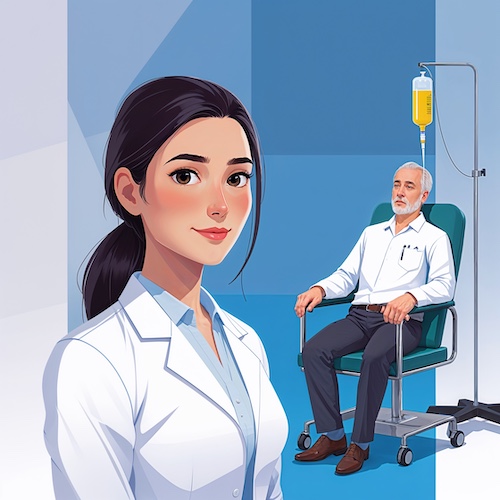Being told that you or a loved one need(s) Total Parenteral Nutrition (or TPN for short) can be a source of
stress. TPN is designed to bypass the eating and digestive processes to bring nutrients directly to the
bloodstream using intravenous nutrition feeding.
It is important to note that TPN can be administered to patients of all ages, including children. In the media
and movies, IV nutrition is typically seen administered to comatose patients. However, there are many other
scenarios in which a patient may require TPN.
Below, we explain what TPN is, how it works, how it is managed, and in which situations it is recommended.
What is Total Parenteral Nutrition?
TPN is the administration of nutrition through an IV method, ensuring nutrition enters the body through the
veins rather than the traditional feeding method. Patients with TPN can receive a variety of nutrients,
typically including protein, fat, minerals, carbohydrate, electrolytes, and vitamins. TPN typically combines the
essential nutrients a patient needs within a solution of water. TPN solutions are customized to individual
requirements, based on health data, patient's age, organ's functions, etc.
Total Parenteral Nutrition must be administered in a fully sterile and clean environment using a central
venous catheter, which is a needle or a catheter placed into one of the large veins going to the heart. The
central venous catheter remains in place. Patients on TPN receive IV feeding 5 to 7 days a week, for 10 to 12
hours each time, either during daytime or nighttime.
Who needs TPN feeding?
Parenteral Nutrition is designed to bypass the digestive system. Doctors recommend it for patients who don't
have a functional gastrointestinal tract, either because the absorbing ability is compromised or because the
tract is interrupted. It can also be used when complete bowel rest is required. Diseases, such as the following,
require TPN:
●Short bowel syndrome
●Gastrointestinal bleeding
●Small bowel obstruction
●Extremely severe Crohn's disease
●Congenital gastrointestinal anomalies
●Cardiac and renal impairment
●Acute pancreatitis
●Etc.
Some patients may require TPN for different periods of time, ranging from temporary IV nutrition feeding to
lifetime PN requirements. More often than not, patients who require long-term TPN can work with their
doctors to arrange home-based therapy for convenience. According to the American Society for Parenteral
and Enteral Nutrition, approximately 25,000 patients receive parenteral nutrition at home.
How do doctors and patients manage TPN therapy?
The purpose of TPN is to deliver essential nutrients to the body. Consequently, the TPN ingredients are
carefully selected to meet each patient's individual nutrition needs.
As mentioned earlier, the medical history of the patient plays a significant role in the choice of ingredients.
Indeed, a patient with kidney disorder is likely to receive less liquid in the TPN to prevent buildup in the
bloodstream. On the other hand, some medical conditions, such as respiratory failure, will require a higher
volume of liquid intake. Additionally, energy, vitamin, and mineral requirements also vary by age group.
Administration in a medical environment
The patient's progress is monitored closely by a medical and nutrition team. For TPN administered in ahospital or care center environment, the specialist team is present within the healthcare establishment andresponsible for:
●Safe storage of TPN doses
●Preparation of each dose
●Customizing dose ingredients based on lab results
●Monitoring of nutrition and other health levels related to the patient's condition
●Sanitizing and sterilizing the central venous catheter, feeding tubes, and the surrounding areas
TPN management at home
For home TPN administration, it's essential for the patient and medical team to work hand-in-hand. Doctors
work in conjunction with a home infusion company and lab results to ensure TPN doses are adapted to the
nutrition requirements of each patient.
A patient receiving TPN at home is under constant monitoring of an interdisciplinary nutrition and medical
team that takes frequent measurements of:
●Patient's weight and BMI
●Electrolytes levels
●Complete blood count: white blood cells, red blood cells, blood platelets
●Liver function tests
●Nutritional assessments
●Other medical tests relevant to the patient's health condition(s)
Patients also receive the support of a qualified home nurse to be trained in the correct administration method
and prevent risks of infection. The patient becomes responsible for some steps of the TPN process:
●Safe storage
●Safe and sterile administration
●Management of other food intakes throughout the day — which must typically be avoided
●Keeping up-to-date with essential tests
Without appropriate follow-up and monitoring, patients with TPN could develop serious health
complications, such as liver dysfunction, glucose anomalies, and catheter-induced sepsis. Some complications
can be reversed or prevented through health monitoring and medical management with an expert team.
Total Parenteral Nutrition can significantly transform the quality of life for patients with long-term conditions
that affect the safe absorption of nutrients through the gastrointestinal tract. Home TPN can protect patients'
independence and flexibility but requires diligent monitoring, appropriate administration care, and dedicated
customized doses.
Don't hesitate to reach out to our team if you wish to find out more about TPN.



